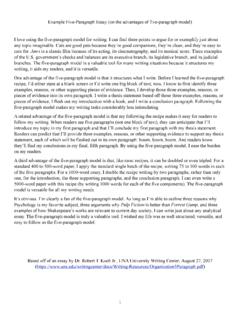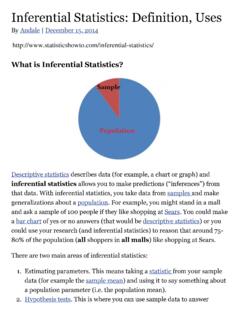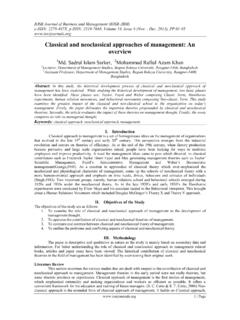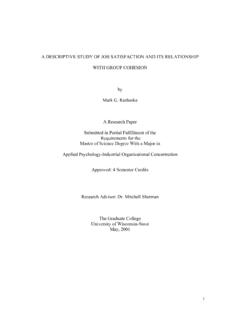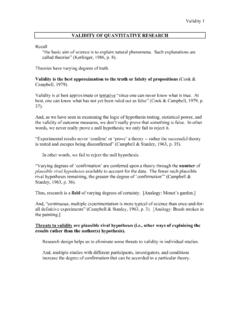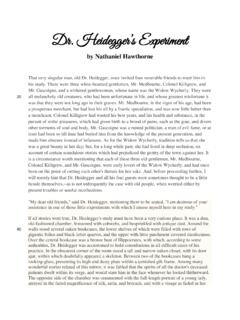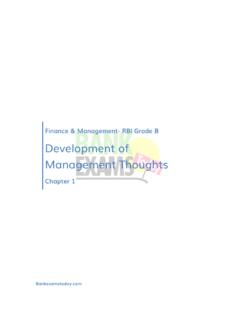Transcription of The 25 Most Influential Psychological Experiments in History
1 The 25 Most Influential PsychologicalExperiments in HistoryBy Kristen FescoePublished January 2016 The field of psychology is a very broad field comprised of many smallerspecialty areas. Each of these specialty areas has been strengthened over theyears by research studies designed to prove or disprove theories andhypotheses that pique the interests of psychologists throughout the each year thousands and thousands of studies are completed in themany specialty areas of psychology, there are a handful that, over the years,have had a lasting impact in the Psychological community as a whole. Someof these were dutifully conducted, keeping within the confines of ethical andpractical guidelines. Others pushed the boundaries of the field and createdcontroversies that still linger to this day.
2 And still others were not designed tobe true Psychological Experiments , but ended up as beacons to thepsychological community in proving or disproving is a list of the 25 most Influential Psychological Experiments still beingtaught to psychology students of A Class DividedStudy Conducted By: Jane ElliottStudy Conducted in 1968 in an Iowa classroomExperiment Details: Jane Elliott s famous experiment was inspired by theassassination of Dr. Martin Luther King Jr. and the inspirational life that heled. The third grade teacher developed an exercise to help her Caucasianstudents understand the effects of racism and divided her class into two separate groups: blue-eyed students andbrown-eyed students. On the first day, she labeled the blue-eyed group as thesuperior group and from that point forward they had extra privileges, leavingthe brown-eyed children to represent the minority group.
3 She discouragedthe groups from interacting and singled out individual students to stress thenegative characteristics of the children in the minority group. What thisexercise showed was that the children s behavior changed almostinstantaneously. The group of blue-eyed students performed betteracademically and even began bullying their brown-eyed classmates. Thebrown-eyed group experienced lower self-confidence and worse academicperformance. The next day, she reversed the roles of the two groups and theblue-eyed students became the minority the end of the experiment , the children were so relieved that they werereported to have embraced one another and agreed that people should not bejudged based on outward appearances. This exercise has since been repeatedmany times with similar more information click here2.
4 Asch Conformity StudyStudy Conducted by: Dr. Solomon AschStudy Conducted in 1951 at Swarthmore CollegeExperiment Details: Dr. Solomon Asch conducted a groundbreaking studythat was designed to evaluate a person s likelihood to conform to a standardwhen there is pressure to do group of participants were shown pictures with lines of various lengths andwere then asked a simple question: Which line is longest? The tricky part ofthis study was that in each group only one person was a true participant. Theothers were actors with a script. Most of the actors were instructed to give thewrong answer. Strangely, the one true participant almost always agreed withthe majority, even though they knew they were giving the wrong results of this study are important when we study social interactionsamong individuals in groups.
5 This study is a famous example of thetemptation many of us experience to conform to a standard during groupsituations and it showed that people often care more about being the same asothers than they do about being more information click here3. Bobo Doll ExperimentStudy Conducted by: Dr. Alburt BanduraStudy Conducted between 1961-1963 at Stanford UniversityExperiment Details: During the early 1960s a great debate beganregarding the ways in which genetics, environmental factors, and sociallearning shaped a child s development. This debate still lingers and iscommonly referred to as the Nature vs. Nurture Debate. Albert Banduraconducted the Bobo Doll experiment to prove that human behavior is largelybased upon social imitation rather than inherited genetic his groundbreaking study he separated participants into three groups: onewas exposed to a video of an adult showing aggressive behavior towards aBobo doll; another was exposed to video of a passive adult playing with theBobo doll; and the third formed a control group.
6 Children watched theirassigned video and then were sent to a room with the same doll they had seenin the video (with the exception of those in the control group). What theresearcher found was that children exposed to the aggressive model weremore likely to exhibit aggressive behavior towards the doll themselves, whilethe other groups showed little imitative aggressive behavior. For thosechildren exposed to the aggressive model, the number of derivative physicalaggressions shown by the boys was and for the study also showed that boys exhibited more aggression when exposed toaggressive male models than boys exposed to aggressive female exposed to aggressive male models, the number of aggressive instancesexhibited by boys averaged 104 compared to aggressive instancesexhibited by boys who were exposed to aggressive female models.
7 While theresults for the girls show similar findings, the results were less drastic. Whenexposed to aggressive female models, the number of aggressive instancesexhibited by girls averaged compared to aggressive instancesexhibited by girls who were exposed to aggressive male models. The resultsconcerning gender differences strongly supported Bandura s secondaryprediction that children will be more strongly influenced by same-sex more information click here4. Car Crash ExperimentStudy Conducted by: Elizabeth Loftus and John PalmerStudy Conducted in 1974 at The University of California in IrvineExperiment Details: Loftus and Palmer set out to prove just how deceivingmemories can be. The 1974 Car Crash experiment was designed to evaluatewhether wording questions a certain way could influence a participant s recallby twisting their memories of a specific participants watched slides of a car accident and were asked to describewhat had happened as if they were eyewitnesses to the scene.
8 Theparticipants were put into two groups and each group was questioned usingdifferent wording such as how fast was the car driving at the time ofimpact? versus how fast was the car going when it smashed into the othercar? The experimenters found that the use of different verbs affected theparticipants memories of the accident, showing that memory can be research suggests that memory can be easily manipulated by questioningtechnique, meaning that information gathered after the event can merge withoriginal memory causing incorrect recall or reconstructive memory. Theaddition of false details to a memory of an event is now referred to asconfabulation. This concept has very important implications for the questionsused in police interviews of more information click here5.
9 Cognitive Dissonance ExperimentStudy Conducted by: Leon Festinger and James CarlsmithStudy Conducted in 1957 at Stanford UniversityExperiment Details: The concept of cognitive dissonance refers to asituation involving conflicting attitudes, beliefs or behaviors. This conflictproduces an inherent feeling of discomfort leading to a change in one of theattitudes, beliefs or behaviors to minimize or eliminate the discomfort andrestore dissonance was first investigated by Leon Festinger, after anobservational study of a cult that believed that the earth was going to bedestroyed by a flood. Out of this study was born an intriguing experimentconducted by Festinger and Carlsmith where participants were asked toperform a series of dull tasks (such as turning pegs in a peg board for anhour).
10 Participant s initial attitudes toward this task were highly were then paid either $1 or $20 to tell a participant waiting in the lobbythat the tasks were really interesting. Almost all of the participants agreed towalk into the waiting room and persuade the next participant that the boringexperiment would be fun. When the participants were later asked to evaluatethe experiment , the participants who were paid only $1 rated the tedious taskas more fun and enjoyable than the participants who were paid $20 to paid only $1 is not sufficient incentive for lying and so those who werepaid $1 experienced dissonance. They could only overcome that dissonanceby coming to believe that the tasks really were interesting and paid $20 provides a reason for turning pegs and there is therefore more information click here6.
